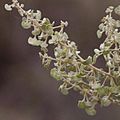Mallee saltbush facts for kids
Quick facts for kids Mallee saltbush |
|
|---|---|
| Scientific classification | |
| Genus: |
Atriplex
|
| Species: |
stipitata
|
| Synonyms | |
|
|
Atriplex stipitata, also called mallee saltbush or kidney saltbush, is a type of shrub. It belongs to the plant family Amaranthaceae. You can find this plant growing across all the mainland states of Australia.
In South Australia, it's special because its flowers bloom all year long! This plant is not currently in danger of disappearing.
Contents
What Does Mallee Saltbush Look Like?
The mallee saltbush is a shrub that stands upright. It can grow up to one meter (about 3 feet) tall. This plant is usually "dioecious." This means that male and female flowers grow on separate plants.
Its leaves are shaped like an oval, which is called "elliptic." The edges of the leaves are smooth, not jagged. The tips of the leaves are either blunt or rounded. Each leaf blade is about 7 to 25 millimeters long. It sits on a small stalk, called a petiole, which is 2 to 3 millimeters long.
Flowers and Fruits
The male flowers of the mallee saltbush grow in separate groups along a spike. The female flowers grow in clusters that are spaced out. These clusters also form slender spikes.
The female flowers have a special part called a "bracteole." This surrounds the plant's ovary. The ovary sits on a thin stalk, or stipe, which can be up to 1 centimeter long. This stalk helps the fruit develop.
How Mallee Saltbush Got Its Name
The scientist George Bentham was the first person to describe A. stipitata in 1870. He gave it its scientific name.
The second part of its name, stipitata, comes from a Latin word. It means "stemmed" or "having a stipe." This name refers to the plant's fruit, which grows on a small stem.
Images for kids


